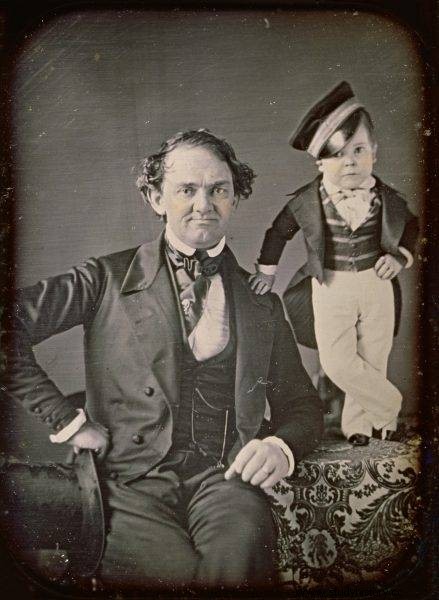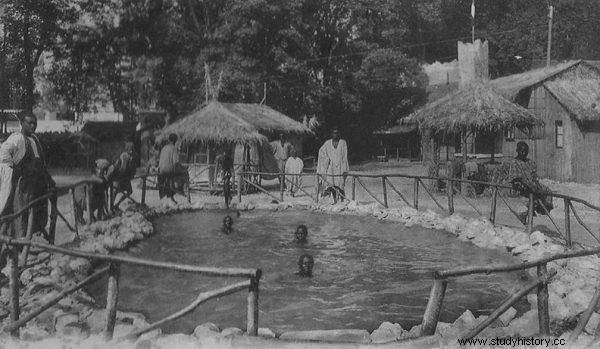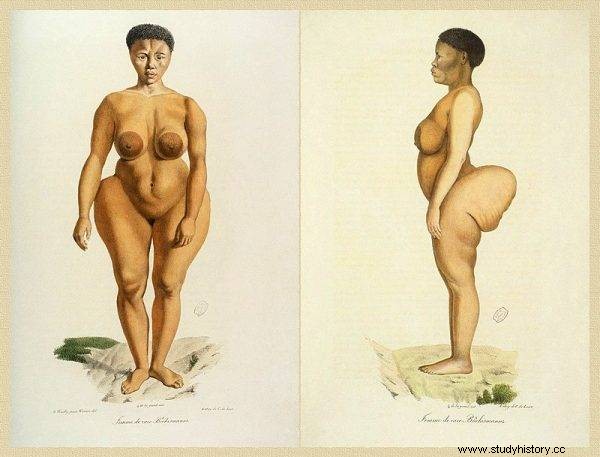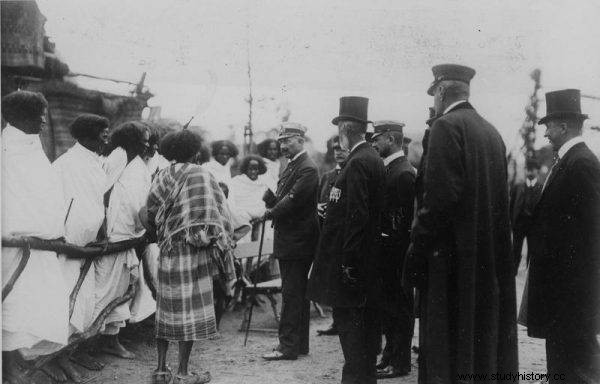In the summer of 1904, as many as 41,000 people stood in line for the "Exhibition of Exotic Nations" in the zoo in Breslau. On the catwalk, you could see live "exhibits" from Tunisia. Light Europe watched the "savages" with a feeling of superiority, but also with fascination. Before putting them behind bars ...
In the nineteenth century, with the development of colonialism and the exploration of subsequent scraps of the globe, the exoticism became fashionable in Europe. Wealthy industrialists, travelers, diplomats and scientists liked to bring all kinds of trinkets from the colonies. New reports from the exotic world were very popular on the Old Continent.
The demand generated supply, especially since the natives brought to Europe as exhibits could be earned well. Nobody thought about objectifying the people who were cast as mascots at the time.
Human zoos were also useful to colonial empires - they were proof of success in exploring new countries, and at the same time justified the need for further expansion. The story of a wild man who, for example, collected or built his homes from dried animal faeces, was proof of his superiority. and the confirmation of the necessity of a civilization mission facing Europe. It is she - as a better developed one - who should take care of such people, carry the torch of education and ... make them, gradually - like herself.
In those days, evolutionism dominated in cultural anthropology and sociology, i.e. the view that societies evolve from simple to advanced forms, and in exotic peoples - at a lower level of development - primitive man can be seen. Today, evolution is largely dismissed as antiquated and chauvinistic. Nowadays, human cultures are treated as equal.
In the nineteenth century, however, full of faith in European supremacy, the prevailing view was that the "savage" should be civilized. This ideological message was behind human zoos, where even chatter from the lower classes could peek at "savages" and boast of their superiority.
Freak shows
Initially, "human zoos" were not advertised as displays of wild or exotic people, but rather as displays of "curiosities", "freaks" and "amazing" characters. One of the first such "institutions" is the exhibition organized in 1835 by the American circus owner - Phineas Taylor Barnum , considered a precursor of the modern entertainment industry.
It was he who organized an "exhibition" of a living man. For marketing purposes, he was announcing that he would show George Washington's 161-year-old wet nurse to the public. In fact, a decrepit, blind black slave, 80-year-old Joyce Heath, "appeared" in front of onlookers.

One of the first such "institutions" is the exhibition organized in 1835 by the American circus owner - Phineas Taylor Barnum, who is considered the precursor of the modern entertainment industry.
At the same time, the British merchant and traveler Robert Hunter in Siam, today's Thailand, found a "treasure", or even two "treasures" that were to give him a fortune. These treasures were the fused twin brothers Chang and Eng Bunker. The brothers stayed together forever - literally. The medicine of that time could not separate them.
Hunter, like a real hunter, had a sense of the trail and for years he made profits from Siamese brothers (this is where the term comes from), but two heads are better than one. When the contract with the Englishman expired, the brothers began to earn money from their situation on their own. They settled in the USA, bought land, and moreover - each of them had a wife. They had 21 children and - as they were always together - together they went on a journey to "the other world". When one brother fell ill and died of bronchitis, the other only survived for a few hours.
Negro Village at Expo
Human zoos began to reach their peak of popularity at the turn of the 19th and 20th centuries. In the 1870s, exhibitions of this type in the largest European metropolises were organized by Carl Hagenbeck - a German circus performer and trainer. In 1874, he brought Samoans and Sami people to Western Europe, whom he showed to the public in an environment intended to pretend their environment. He advertised the Human Zoo as displays of "spotless" nations.
In 1876, encouraged by his success, he brought Nubians from Africa to the Old Continent. To see "Negro villages" ( negro villages ), as the exhibition with their participation was called, there were enormous queues of people in Berlin, Paris and London.
In 1877 in France, Nubians and Inuit were presented as part of "ethnological spectacles". The exhibition was seen by over a million visitors. From that moment until 1912, as many as 30 exhibitions of "wild peoples" took place in the Paris Garden of Acclimatization. In 1878 and 1889, at the World Exhibition (on the occasion of which the Eiffel Tower was built), civilized European audiences enjoyed watching black Africans. "Negro village" ( village nègre ), to which as many as 400 "inhabitants" from Africa were brought, were visited by a total of 28 million people.
In 1906, visitors to the zoo in New York could see an unusual exhibition. There was a human in a cage with a chimpanzee. A Congolese pygmy went there to "explain" the meanders of evolution to the guests. The exhibition was signed with the slogan missing link.

In order to see the "negro villages", huge queues were formed in Berlin, Paris and London.
Participants in such exhibitions were not necessarily forced to do so by force. At the time of the popularity of human zoos, there were specialized companies that "recruited" residents of exotic countries . They often agreed voluntarily, deluded by the specter of fame and prosperity in rich Europe. Of course, they had no idea what they were really signing up for. Often, instead of money, they faced poverty, and their caretakers took over. In turn, fame came with a humiliation that many could not cope with.
The aforementioned pygmy from the catwalk for monkeys - Ota Benga - did not mentally elevate participation in the show. The boy was brought to the USA by Philips Verner, the organizer of "human zoos", who bought him from slave traders. He noticed the characteristic filed teeth of Ota. The pygmy, after a few years of showing up to the public surrounded by monkeys, is now free. He went to an orphanage and learned English. He also got the opportunity to return to his native Congo. This, however, failed due to the outbreak of World War I. Distraught, struggling with depression, Ota committed suicide by shooting himself straight in the heart.
Hotentock Venus
While human zoos were purported to broaden knowledge of other cultures, they actually fulfilled a perverse desire to peek, scoff at others, and take pleasure in stripping people of intimacy. In that sense, they had the same element as pornography.
The sexual theme invariably accompanied such expositions . Honorable ladies and elegant gentlemen banged doors and windows to admire the anatomical details of the "wild". Among urban legends there are stories and about how for big money respectable matrons bought hot nights with a "wild" lover . Was it so or were they just rumors? We don't know that.
However, we know for sure that the exhibitions, during which the abundance and flaws of the bodies of the "savages" were loudly commented on, must have been a tremendous humiliation for these people. And it was so. Puritan Victorian England, which haunted all “shaves” so much, had no hesitation in viewing a naked man, but only on the condition that she did not treat him as a fully fledged human being, but more like an animal or a thing.
Saartjie Baartman, a black slave from a South African Boer farm, became a symbol of the objectification of human exhibits. In 1910 the Baartman anatomy, typical of South African Hottentot women (oversized buttocks and labia - the so-called A hotentock apron), interested Alexander Dunlop - a British naval surgeon.

Saartjie Baartman, a black slave from a South African Boer farm, has become a symbol of the objectification of human exhibits.
It was he who persuaded the slave owner - Hendrick Ceasar - to exhibit Saartje in the European "human zoo", offering him a vision of great earnings. So it happened. Soon after, the three of them boarded a ship to London. It should be noted that Saartjie voluntarily agreed to this trip. The owner promised her a fortune and freedom.
Venus of Hotentock - because that was what the London public called it (the chatter used another term:fat ass) "appeared" in a cage from then on on a dais in a rented unit on Piccadilly Street. Its task was, inter alia, leaving the cage every now and then, walking alongside the audience so that it can get a good look at her body. She had to endure biting remarks as well as the touch of more insistent "customers".
With time, the London public got bored with Hotentock's Venus, and its current owner began to have problems with the law, due to the accusation of slave trade - already banned in Great Britain. For the purposes of the court, he fabricated a contract that was to certify that a woman was paid for her performances. In fact, it was cheated and abused.
Eventually, Saartjie and her guardians left for the Netherlands and then France. There she continued her "career", which she endured worse and worse. In addition to financial exploitation, was also physically abused by successive principals , organizers of Hotentock Venus shows - the owner of the circus, exhibitor of exotic animals, etc.
It was also an interesting "object" for scientific research. In 1815, shortly before her death, Saartjie, who lived in poverty and was already addicted to alcohol, was examined by the anatomist Georges Cuvier. Her portraits were drawn, parts of her body were measured and her body was commented on. Zoologist Étienne Geoffroy Saint-Hilaire wrote in his report that its "front part of the mouth is even larger than that of an orangutan." In turn, the "extraordinary size of the buttocks" compared to the appearance of female Lapunder and Mandrillus monkeys during menstruation.
European science was very interested in this unique "specimen", failing to see the man who needed help. Eventually Hotentock's Venus died in poverty and solitude in Paris in 1815.
Breslau Zoo
Every now and then one hears comments stigmatizing the alleged Polish provincialism, the lack of knowledge and contact with current trends - cultural, civilization, etc. a supposedly civilized world.
This was also the case with the human zoo. In Poland, which was then under partitions, there were no similar exhibitions. We didn't organize them ourselves. We did not have colonialism on our account, although it is a spoonful of tar that we wanted to equal the "powers" in this matter. Just before the outbreak of World War II, Polish elites dreamed of Polish colonies - in Liberia, Madagascar or Brazil. Nothing came of it. And that's good - today we don't have to be ashamed of the legacy of colonialism.

There were also no human zoos in Poland. Instead, they visited their neighbors - incl. in German Breslau or Hamburg
There were also no human zoos in Poland. Instead, they visited their neighbors - incl. in German Breslau, which is today's Wrocław. In 1876, the management of the zoo decided to organize an exhibition of "exotic peoples". Bedouins from North Africa and Tunisians were brought to Breslau. On specially arranged catwalks, the newcomers were to present typical genre scenes from their lives - incl. hunt, javelin, ride horses.
The exhibition turned out to be a great attendance and financial success, which is why it was repeated. Today it is estimated that up to 320,000 people passed through the human zoo in Breslau until the 1920s. visitors.
The Human Zoo in Brussels
In the post-war era, the human zoo became one of the symbols of racism and colonialism, but it was not so easy for Western societies to say goodbye to an objectifying attitude to other cultures. Back in 1958, a show of live exhibits was organized in today's "capital" of the European Union. The "Congo village" was presented during the World Exhibition. Viewers from behind the fence watched, among others black children.
The Congolese village is the last "human zoo". Today, such initiatives are stigmatized, but the idea behind them, i.e. voyeurism, group mockery, breaking taboos and intimacy, feeding on otherness - has not passed away.
It is sometimes believed that human zoos were the first reality shows. Today, the same - in principle - entertainment has been taken over by the media. People are presented in cages, in isolation, on islands, in houses, in confinement. It is all the same mechanism that was behind putting people in cages at the turn of the 20th century.
Bibliography:
- Bradford P. V., Blume H., Ota Benga:The Pygmy in the Zoo . New York:St. Martins Press 1992.
- Clifton C. Crais, Pamela Scully, Sara Baartman and the Hottentot Venus:A Ghost Story and a Biography . Princeton University Press 2009
- Sandrel C., Vénus &hottentote. Sarah Bartman . Perrin 2010.
- Kuchta K., The Human Zoo in Breslau , PlacesWeWroclawiu.pl (access:June 28, 2021).
- February P., The campaign against the Belgians is underway. The Internet reproaches them of the human zoo , naTemat.pl (access:June 28, 2021).
- "Human Zoo" - public exhibitions of "live exhibits" , WP Opinions (accessed on:28/06/2021).
- Maritime and Colonial League , czas.pl (access:June 28, 2021).
